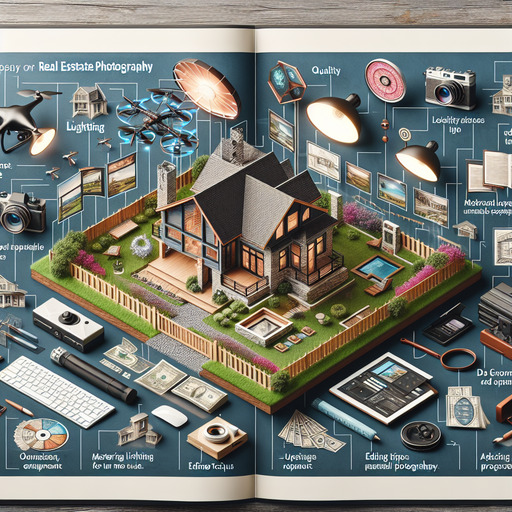
-
Table of Contents
- Mastering Real Estate Photography: Tips, Techniques, and Tools
- Understanding the Importance of Real Estate Photography
- Why Quality Matters
- Essential Real Estate Photography Tips
- 1. Use the Right Equipment
- 2. Master the Lighting
- 3. Perfect Your Composition
- Advanced Techniques: Real Estate Drone Photography
- Benefits of Drone Photography
- Editing for Impact: Real Estate Photography Editing
- Key Editing Techniques
- Pricing Your Real Estate Photography Services
- Case Study: Successful Pricing Strategy
- Conclusion
- Questions and Answers
- 1. What equipment is essential for real estate photography?
- 2. How can drone photography benefit real estate listings?
- 3. What are some key editing techniques for real estate photos?
Mastering Real Estate Photography: Tips, Techniques, and Tools
In the competitive world of real estate, first impressions are everything. High-quality real estate photography can make or break a property listing, influencing potential buyers’ decisions before they even step foot inside. This guide will explore essential tips, techniques, and tools to elevate your real estate photography game, ensuring your listings stand out in the crowded market.
Understanding the Importance of Real Estate Photography
Real estate photography is more than just snapping pictures of a property. It’s about capturing the essence and potential of a space, enticing buyers to envision themselves living there. According to a study by the National Association of Realtors, 87% of home buyers found photos to be the most useful feature of real estate websites. This statistic underscores the critical role photography plays in real estate marketing.
Why Quality Matters
- First Impressions: High-quality images create a positive first impression, increasing the likelihood of attracting potential buyers.
- Increased Engagement: Listings with professional photos receive 118% more views than those without.
- Faster Sales: Homes with high-quality images sell 32% faster than those with lower-quality visuals.
Essential Real Estate Photography Tips
To capture stunning real estate photos, consider these practical tips:
1. Use the Right Equipment
Investing in the right real estate photography equipment is crucial. A DSLR camera with a wide-angle lens is ideal for capturing expansive interior shots. Additionally, a sturdy tripod ensures stability and sharpness in your images.
2. Master the Lighting
Lighting can make or break a photo. Natural light is your best friend, so schedule shoots during the day when the property is well-lit. Use additional lighting equipment to fill in shadows and highlight key features.
3. Perfect Your Composition
Composition is key in real estate photography. Use the rule of thirds to create balanced and visually appealing images. Ensure vertical lines are straight, and avoid clutter in your shots to maintain focus on the property’s features.
Advanced Techniques: Real Estate Drone Photography
Real estate drone photography offers a unique perspective, showcasing properties from above. This technique is particularly useful for large estates or properties with stunning landscapes.
Benefits of Drone Photography
- Showcase Property Size: Capture the full extent of a property, including land and surrounding areas.
- Highlight Unique Features: Emphasize features like pools, gardens, and nearby amenities.
- Create Engaging Content: Aerial shots add a dynamic element to listings, attracting more interest.
Editing for Impact: Real Estate Photography Editing
Post-processing is an essential step in real estate photography. Editing software like Adobe Lightroom or Photoshop can enhance images, correcting exposure, color balance, and perspective.
Key Editing Techniques
- Adjust Exposure: Ensure images are neither too dark nor too bright.
- Correct Distortion: Fix lens distortion to maintain straight lines and accurate proportions.
- Enhance Colors: Boost colors to make the property appear vibrant and inviting.
Pricing Your Real Estate Photography Services
Determining real estate photography pricing can be challenging. Consider factors like location, property size, and the complexity of the shoot. Research competitors’ rates and adjust your pricing strategy accordingly.
Case Study: Successful Pricing Strategy
One photographer increased their client base by offering tiered pricing packages, catering to different budgets and needs. This approach allowed them to attract a wider range of clients while maximizing revenue.
Conclusion
Mastering real estate photography requires a blend of technical skills, creativity, and strategic planning. By investing in the right equipment, mastering lighting and composition, and utilizing advanced techniques like drone photography, you can create compelling images that drive sales. Remember, the key to success lies in continuous learning and adapting to industry trends.
For more insights on real estate photography, check out this Wikipedia page on real estate photography.
Questions and Answers
1. What equipment is essential for real estate photography?
A DSLR camera with a wide-angle lens, a sturdy tripod, and lighting equipment are essential for capturing high-quality real estate photos.
2. How can drone photography benefit real estate listings?
Drone photography provides a unique aerial perspective, showcasing the property’s size, features, and surrounding areas, making listings more engaging.
3. What are some key editing techniques for real estate photos?
Key editing techniques include adjusting exposure, correcting distortion, and enhancing colors to create vibrant and inviting images.
If you’re interested in learning more about our real estate photography services or have any questions, please contact us.